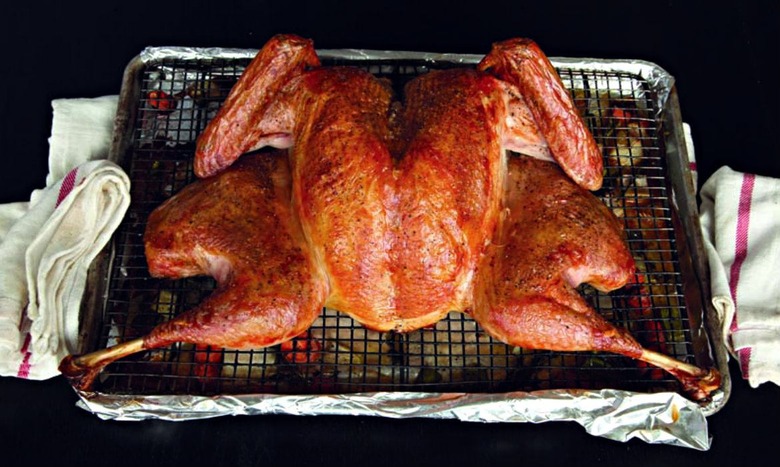The Easiest And Fastest: Roasted Butterflied Turkey
The Easiest And Fastest: Roasted Butterflied Turkey
As with butterflied chicken, cooking a turkey like this solves pretty much every problem that a whole turkey has, making the actual roasting process completely idiot-proof. As long as you’ve got good kitchen shears, an instant-read thermometer, and a few brain cells to rub together, you should be able to put a perfect turkey on the table any day of the year.With a quick-cooking chicken, you can go straight on a rack set in a foil-lined rimmed baking sheet. Do this with a turkey, and the drippings will start to burn before the turkey is done. To solve this problem, and add some flavor in the process, I spread a layer of chopped vegetables in my roasting pan. The vegetables release juices as they cook, preventing the drippings from burning and creating a flavorful base for you to add to your gravy at the end.Recipes and Photography from The Food Lab: Better Home Cooking Through Science by J. Kenji López-Alt. Copyright © 2015 by J. Kenji López-Alt. With permission of the publisher, W. W. Norton & Company, Inc. All rights reserved.
Servings
10
servings

Ingredients
- 3 large onions, roughly chopped
- 3 large carrots, peeled and roughly chopped
- 4 stalks celery, roughly chopped
- 12 thyme sprigs
- 2 tablespoon vegetable oil
- 1 whole turkey, twelve to fourteen pounds, butterflied, backbone, neck, and giblets reserved
- kosher salt and freshly ground black pepper, to taste
- 6 cup homemade or low-sodium canned chicken or turkey stock
- 3 bay leaves
- 3 tablespoon unsalted butter
- 1/4 cup all-purpose flour
Directions
- Adjust an oven rack to the middle position and preheat the oven to 450 degrees F. Line a rimmed baking sheet or broiler pan with aluminum foil. Scatter two-thirds of the onions, carrots, celery, and thyme sprigs across the bottom of the pan. Place a wire rack or slotted broiler rack on top of the vegetables.
- Pat the turkey dry with paper towels. Loosen the turkey skin from the breasts. Rub the turkey all over and under the skin with 1 tablespoon of the oil. Season liberally all over with salt and black pepper (go easy on the salt if the bird was dry-brined). Tuck the wing tips under the bird. Place the turkey on the rack, arranging so that it does not overhang the edges, and press down on the breastbone to flatten the breasts slightly.
- Roast, rotating the pan occasionally, until an instant-read thermometer inserted into the deepest part of the breast registers 150 degrees F and the thighs register at least 165 degrees F, about 80 minutes. If the vegetables start to burn or smoke, add 1 cup water to the roasting pan.
- While the turkey roasts, make the gravy: Roughly chop the neck, backbone, and giblets. Heat the remaining 1 tablespoon oil in a 3-quart saucepan over high heat until shimmering. Add the chopped turkey parts and cook, stirring occasionally, until lightly browned, about 5 minutes. Add the remaining onions, carrots, and celery and cook, stirring occasionally, until the vegetables start to soften and brown in spots, another 5 minutes or so. Add the stock, the remaining thyme, and the bay leaves and bring to a boil, then reduce to a bare simmer and cook for 45 minutes. Strain the stock through a fine mesh strainer into a 2-quart liquid measuring cup or a bowl; discard the solids. Skim off any fat from the surface of the stock.
- Melt the butter in a 2-quart saucepan over medium-high heat. Add the flour and cook, stirring constantly, until golden brown, about 3 minutes. Whisking constantly, add the stock in a thin, steady stream until it is all incorporated. Bring to a boil, then reduce to a simmer and cook until reduced to about 4 cups, about 20 minutes. Season to taste with salt and pepper, cover, and keep warm.
- When the turkey is cooked, remove from the oven and transfer the rack to a rimmed baking sheet. Tent the turkey with aluminum foil and allow to rest at room temperature for 20 minutes before carving.
- Carefully pour any collected juices from the roasting pan through a fine-mesh strainer into a liquid measuring cup or a bowl. Skim off the fat and discard. Whisk the juices into the gravy.
- Carve the turkey and serve with the gravy.